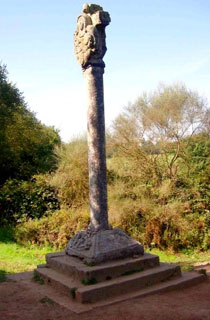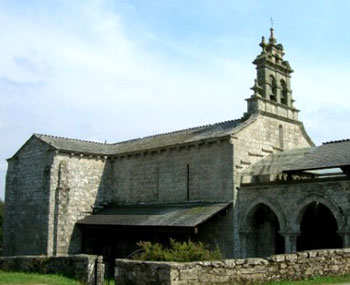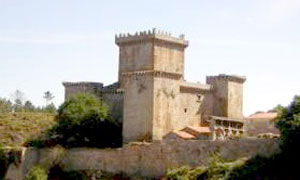Camino de Santiago - French Way - Stage 30 - Portomarín to Palas de Rei
Total distance: 24.5 km
To leave Portomarín walk back towards the Escalinata de Nuestra Señora de las Nieves, the little chapel at the top of the stairs. Following the yellow arrows you will cross an old footbridge over the Río Torres which will take you down a minor road then down country track gradually walking uphill to the old main road. When you reach the main road cross over and walk down the track on the other side. Over the next few kilometres you will be walking more or less parallel to the main road passing through the hamlet of Toxibó, eventually reaching the village of Gonzar 7.5 kilometres out from Portomarín.
In Gonzar there are a couple of albergues, one private, which has a café which does reasonable food, and the other municipal. There is a small café/bar on the road but this tends to be open mainly in the summer.
Heading out of Gonzar take a track just past one of the albergues and after 1 kilometre you enter the village of Castromaior. The village was named after a large hill fort or castro in the vicinity, the remains of which can still be seen up on the hillside.
There is a local story that tells of a girl who took pig snouts as an offering to the gods at the annual festival. She returned to the area the next day to see that these snouts had turned into coal which she promptly threw away. However, something caused her to keep one of them and she returned home. On waking the next day she found that the lump of coal had turned into gold and she ran back to the village to find the rest of the coal she had thrown away only to find that it had all disappeared. No doubt picked up by the other villagers.
The path continues through the village and after 2.5 kilometres you arrive at Hospital de la Cruz. As the name suggests there was once a pilgrim hospital here but other than giving the village its name nothing remains of the hospital. Accommodation can be found at the albergue and a small bar/restaurant is close by if you want to grab a bite to eat.
Walk past the albergue and across a footbridge down an old country road for about 1.5 kilometres until you reach Ventas de Narón.
Like the previous village of Hospital de la Cruz the village of Ventas de Narón also had a pilgrim hospital built in the 13th century by the Knights Templar. Unfortunately the only remaining intact part of the hospital is the small Ermita de Santa María Magdalena, some of the ruins can still be seen close by. This area is also believed to be the site of a battle between the Christians and the moors in the 9th century with the Christians coming out victorious over the Emir of Córdoba.
There are 3 albergues in Ventas de Narón, 2 are privately run and both have cafés which provide meals and the other is run by the Xunta de Galicia.

Walk out of the village passing the small chapel and a wooden wayside cross and up to the Sierra de Ligonde. This is the highest point on this section at around 756 metres above sea level and provides some great views over the valleys below. The path now begins to descend and takes you through the hamlets of Previsa and Lameiros. Between Lameiros and the next village of Ligonde you will find a 17th century cruceiro which is said to be the most famous cruceiro on the Camino. A little further on and just before you enter Ligonde you will find another stone cross which marks the location of an ancient pilgrim cemetery, all that remains of a former pilgrim hospital.
Ligonde has a couple of albergues but only the municipal albergue is open all the year round, the other which is privately run opens only during the summer months. About 1 kilometre further down the road you come to Eirexe (also known as Airexe) which has an albergue and a couple of pensiones if you were unable to get a place in Ligonde. There is a small café across the road from the albergue which does food.
The path continues now past a lavadero and towards the hamlet of As Cruces. At the crossroads here cross over and head down the road which has a sign saying Palas de Rey 10 kilometres. This will take you through the hamlets of Portos and A Calzada both of which have an albergue.

If you want to take a slight detour at A Calzada you can go to the Monasterio de San Salvador at Vilar de Donas. This 13th century monastery was donated to the Knights of Santiago (Caballeros de Santiago) in 1224 by the noble family Arias de Monterroso. The church that remains was built in the 14th century over the previous church. This national monument is the official burial place of the Knights of Santiago and contains some impressive frescoes. Well worth a detour.
Back at A Calzada the path takes you through the hamlets of Lestedo where there is a hostal that provides meals, Valos (also known as Balos), Mamurria and Brea. The track now climbs through the hamlet of O Rosario and up to the Alto de Rosario from where, on a clear day, you can see Monte Pico Sacro the mountain that overlooks Santiago de Compostela. The path now descends passing by an albergue and a hostal and down into the small town of Palas do Rei.
Palas de Rei or pallatium regis was given this name when the Visigoth King Witiza who reigned here during the early 8th century, built a palace here. Again like many other towns and villages we have passed through Palas de Rei prospered during the height of the Camino de Santiago during the Middle Ages and there are a number of Pazos and noble houses dotted around to show the affluence of the area. One of these, the Pazo de Ulloa is said to have once been the residence of the Galician Queen Doña Urraca.
The town is nice enough with most of town life revolving around the Plaza del Concello. There is a small church la Iglesia de San Tirso which had originally been built in the late 12th, early 13th century but it has undergone numerous changes over the centuries and the only original part of the church is the Romanesque doorway.
Accommodation can be found at a number of albergues and hostals a couple of which offer meals. There are a number of restaurants in the town that offer pilgrim menus as well as a couple of supermarkets, bars and cafés.

About 4 kilometres from Palas de Rei there is a well preserved castle called Castelo de Pambre which was built by Don Gonzalo Ozores de Ullloa during the 14th century. The castle was lucky to survive the Irmandiño uprising and was sold by the Duke of Alba to a local called Don Jose Soto in 1895 for the grand sum of 27,000 pesetas. It then passed through the hands of the Moreiras Blanco family and was latterly owned by Don Manuel Taboada Fernandez the count of Borrazeiros. When Don Manuel passed away it was taken over by a religious order and is believed to have been sold to the Xunta who will open it as a tourist attraction.

